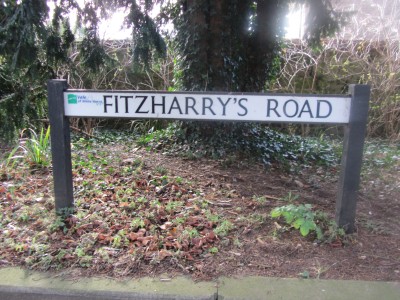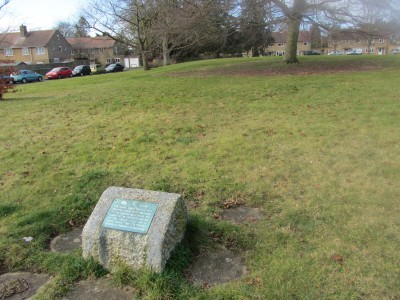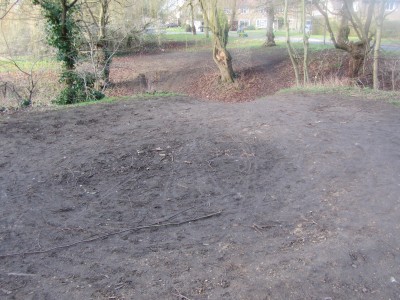
Just off Bath Street, up Fitzharry’s Road, can be found a large green space in the centre of a 1950s estate. The estate was developed as housing for workers at the atomic energy research establishment in nearby Harwell.

The green space with the plaque is what reamins of Fitzharry’s House – a large historic house demolished in the 1950s. It had a long history and The Friends of Abingdon tried to save it – but in vain.

Nearby, close to the River Stert, is a similarly framed plaque. It describes the mound beyond – which is the remaining half of what was once a Motte and Bailey. This fortification was constructed in the years after the Norman Conquest when the new overlords could not always sleep soundly in their beds after fining and taxing locals above the odds

The top of the Motte is ten to twelve strides across, and about ten strides deep. It is still surrounded by a ditch which was once the moat. The Bailey that stood on the Motte would not have withstood an attack by a visting army but would presumably have kept a marauding mob of locals at bay on a Friday night.
The Ftitzharry name comes from a 13th knight, Hugh FitzHarry, who sold this estate to Abingdon Abbey before going off to the crusades. He probably got bored of fining locals whose pigs had strayed onto his estate, and got fired up by something really really worth fighting about – the Holy Land. Nothing much has changed.
Ah Nostalgia ! It’s those old Australian linear measurements again. A “Stride” ?
Random thoughts: Would it be non-PC to probe the origins of names like “Hugh Fitz-Harry” (Punctuation, Spelling and Capitalisation are still relevant today)
I always wondered why the historical colour for Abingdon is Pink (sorry, Cerise)?
http://www.friendsofabingdon.org.uk/achievefitzmanor.html
Very sad indeed.
Those pictures bring back memories of daring decents on pushbikes (or whatever had wheels on it!) and tarzan swings! Oh we used to spend alot of our school holidays sneaking off across the estates to play at the Fitzharrys mound.
Do any pictures of Fitzharrys Manor exist?
http://www.friendsofabingdon.org.uk/achievefitzmanor.html
– picture of the manor
Spike – according to Wikipedia “Fitz forms a prefix to patronymic surnames of Anglo-Norman origin. This usage derives from the Norman fiz / filz, meaning “son of”, which was coupled with the name of the father (e.g. Fitz Gilbert, meaning “son of Gilbert”) … It later was applied to the illegitimate sons of princes.”
I did’t know the historical colour for Abingdon town was cerise – thought it was dark green and gold. Are you thinking of the colour worn by Abingdon School?
“Are you thinking of the colour worn by Abingdon School?”
My post was ever so slightly tongue-in-cheek. It is now just “Abingdon” according to another recent post by Backstreeter. Do keep up ! Thanks for the Wikiref.
This is always a stimulating blogsite. Excellent for keeping briefed on Abingdon goings-on from here in deepest Wiltshire – thanks BS.
There is a picture of Fitzharry’s Manor in’Abingdon in Camera – a portrait of a country market town’ by M J Thomas.
The manor was founded after the Norman Conquest, and passed through many hands including the Tesdale and Bostock families. The house became a girl’s school in WW2 and was finally demolished in 1953.
Barbara,
Thanks for the link. It looked an impressive building. I also saw a photo of a carpet factory near the town bridge and I am wondering what other large buildings have gone, apart from the abbey?
Peter – if you can get a copy of Abingdon Past and Present by Elizabeth Drury and Judy Thomas and the follow up More of Abingdon, probably available from the bookshop in the precinct, there are loads of pics of other beautiful buildings that have been destroyed over the years. Places like the Corn Exchange, old Fire Station, Bury Street School, Caldecott House – the list goes on and on.
I remember vividly when I was a kid riding up and down that mound on my bike! I also remember coming off my bike a few times as well ha ha!!
I was wondering if the ‘bid dipper’ is still in the woods opposite. There was a path that went around the top of the wooded area and it went quite steeply up and down on the way back down to the path cutting through the woods?
I went to school at Fitzharries during the war. It was a small school, just over fifty girls and one little boy. I was four when I went but my memories of the building are very vivid. I can still remember the hall and the sweet cupboard and the rope which served as a banister up the back stairs. I can also remember many of the girls who were there who, like me, probably have never forgotten the ground plan of the place, what it smelled like, where they slept and particularly the vast yew tree which stood on the lawn. It was criminal to demolish this historic building.
M y sister and I went to !Fitzharrys too and we went with the school when it moved to Tidebrook Place. You may remember Lindsay (my sister) and Carolyn (me) Porter. Lindsay is still in contact with Mary Bayliss and I was friends with Janet Strutt until she died. Do any of these names mean anything to you? Certainly I remember the sweets cupboard and the cloisters and prettywell everywhere. It was a lovely, but very cold, house such a pity they pulled it down.
I lived @ number 8 Stanford Drive until 1957 when we moved to Dorchester as my father transferred from Harwell to Winfrith. I remember playing in the big house which was demolished also roller skating down the hill in Stamford Drive.
I still have a scar from riding my tricycle into the moat.